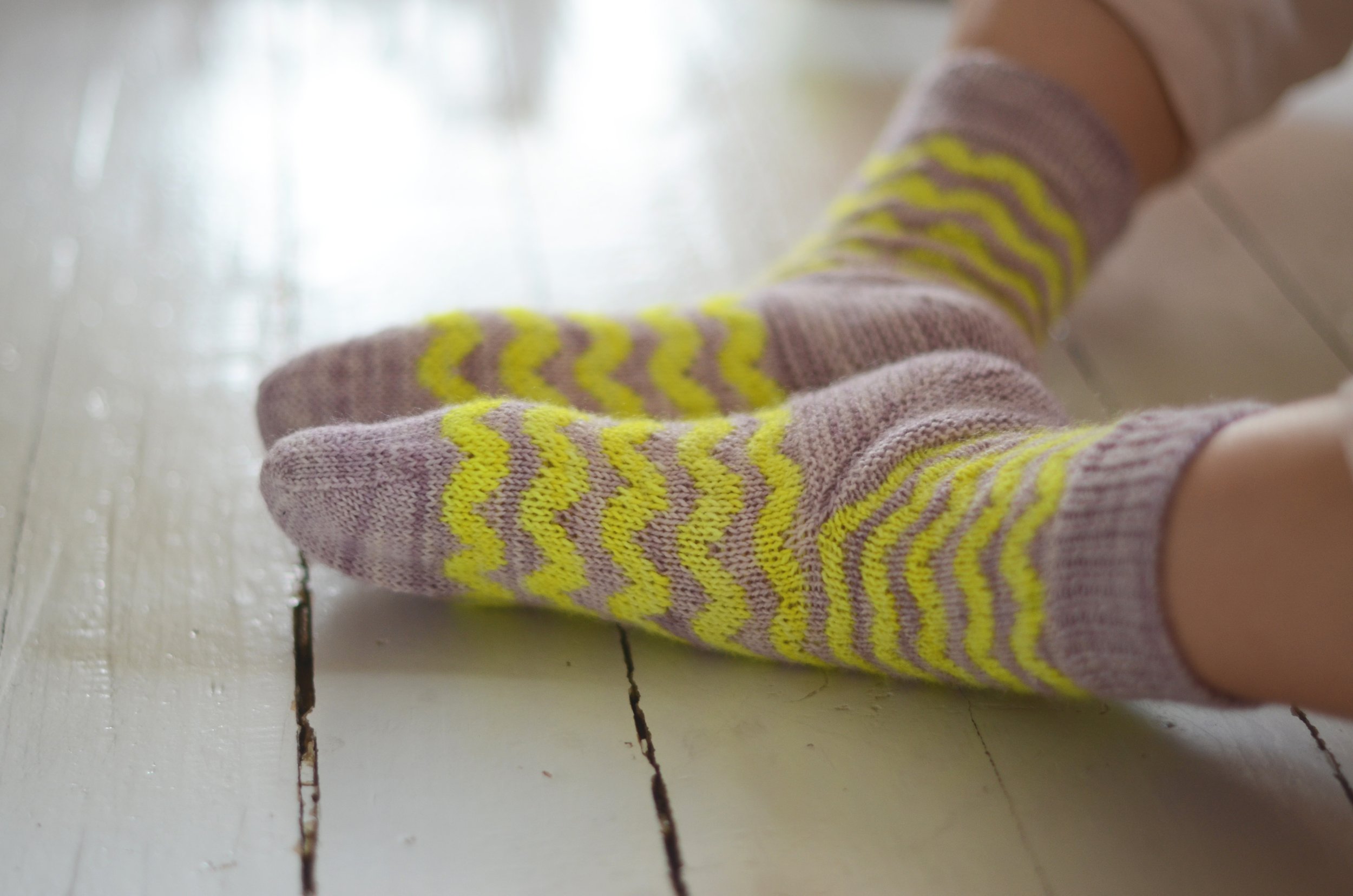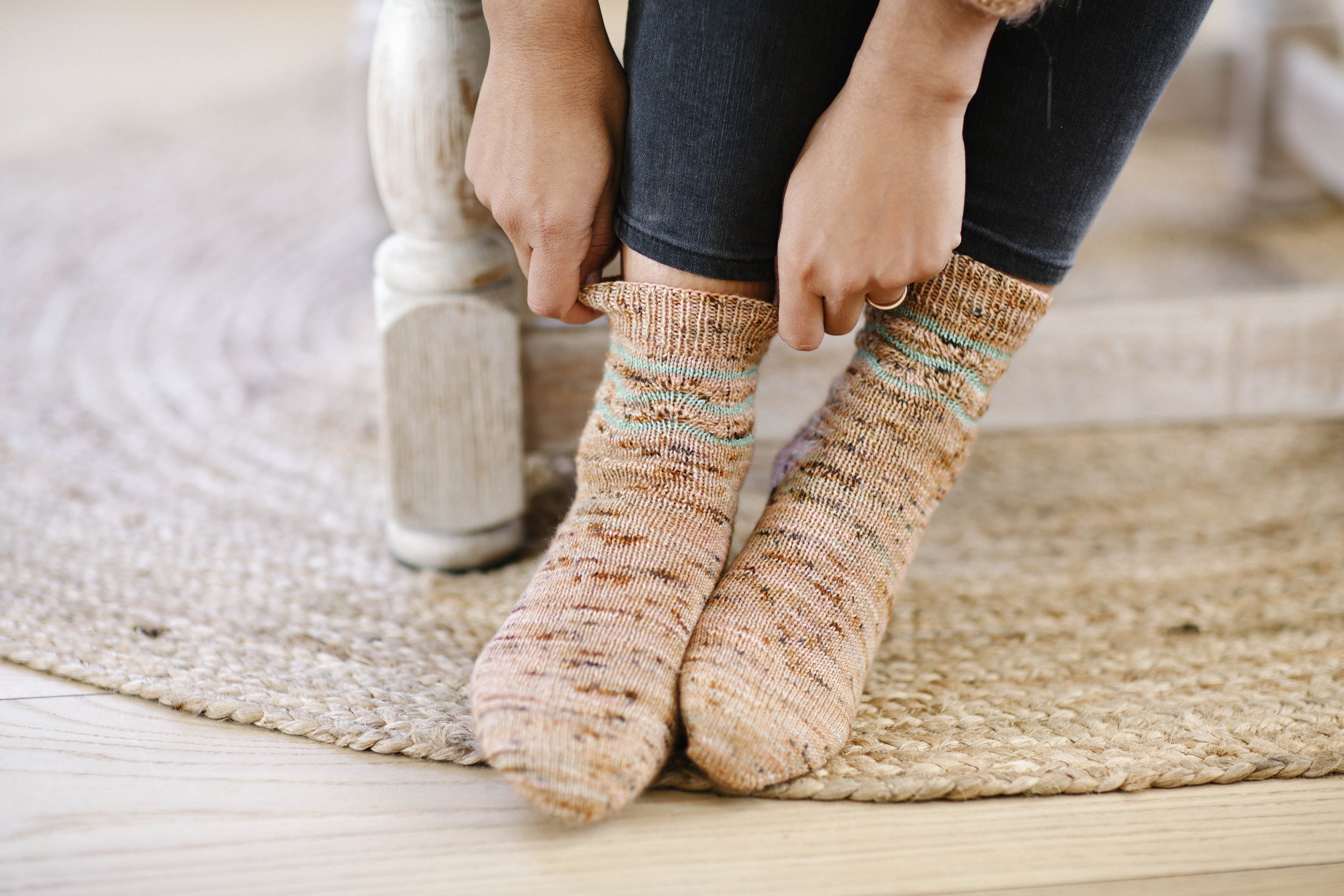Choosing the Best Yarn for Socks
Our Spring Socks KAL stared a few days ago! I’m so excited to see our projects grow and cast on a new pair of socks myself. If you haven’t seen all the details about this knit-along - just go read my previous blog post. I hope you’ll join us!
Today I’m also starting a series of posts on sock knitting! I know this has been the theme this Spring, but it certainly started way earlier: socks are my new favourite little thing to knit. First and foremost it’s time to take a closer look at all the yarn options we have for sock knitting.
Choosing the right yarn for your socks
I’ve always been the one who goes through knitted socks like crazy; nothing lasts in my feet. And the same goes for my entire family. But with trial and error I have found my favourite yarns and also the love for sock knitting! Today I want to talk everything you need to know about selecting the best yarn for strong, cozy, and long-lasting socks.
Nowadays I feel that sock knitting is one of the most satisfying projects a knitter can take on. Sock projects are small, portable, and endlessly customisable and hand-knit socks bring warmth, comfort, and even a bit of everyday luxury to our wardrobes. But not all yarns are created equal when it comes to socks! A beautiful skein might knit up into a stunning sweater or shawl, but that doesn’t mean it will hold up under the pressure of daily wear and friction inside shoes.
The right yarn choice makes the difference between socks that last for years and ones that wear through after just a few outings. Factors like fibre content, yarn structure, and sometimes even colour choices play an important role in crafting durable, comfortable, and well-fitting socks. Let’s dive into what makes the best sock yarns.
Fibre Content: What Works Best?
Wool is the gold standard for socks. It is hands down the most popular choice for sock knitting, and for a good reason. It has excellent elasticity, keeping socks snug and well-fitted while wearing them. Wool is also naturally moisture-wicking, meaning your feet stay dry, reducing the risk of blisters. In addition, it regulates temperature quite well, keeping feet warm in winter and cool in summer.
For the best results, look for merino wool blends with a significant added nylon content for durability. If you prefer non-super-wash wools for structure and resilience, Bluefaced Leicester (BFL) and Corriedale are two great options, as they have longer fibres and wear better over time.
Super-wash wool is treated to prevent felting, making it machine washable and more convenient especially for an item like sock that you will want to wash regularly. However, it can be a bit more prone to stretching out, and some super-wash processes reduce wool’s natural moisture-wicking properties.
Non-super-wash wool retains more of its original structure and can help socks hold their shape better. If you don’t mind hand-washing, it’s an excellent choice for sturdy socks.
For the most durable socks, a wool/nylon blend (typically 75-85% wool, 15-25% nylon) is ideal. Nylon adds strength to high-friction areas like heels and toes, preventing holes and extending the lifespan of your socks.
Cotton is breathable and cool, making it a good choice for summer socks. However, these fibres lack elasticity, so it’s best blended with a small amount of wool or elastic fibres (like Lycra or Spandex) to help maintain shape. These fibres will work great for warm weather sock knitting. Bamboo is soft and has natural antibacterial properties, making it a great choice for sensitive feet. But like cotton, it doesn’t stretch much, so blends work best.
Luxury fibres like silk, alpaca, and cashmere add softness and warmth but aren’t always the best for everyday socks. Silk can be durable when blended with wool and adds a slight sheen. Alpaca is incredibly warm but lacks elasticity and can felt easily. Cashmere is wonderfully soft but wears out quickly—best saved for occasional wear socks. If you want to add a touch of luxury without sacrificing durability, look for a wool/nylon blend with 10-15% silk or cashmere.
Yarn Weight & Ply: Finding the Right Thickness
Most sock patterns are designed for fingering-weight (4-ply) yarn, which strikes the perfect balance between warmth and wearability. However, thicker options exist. Sport & DK-weight socks are great for boot socks or extra warmth. Lace-weight socks create a delicate, lightweight alternative for summer - and definitely something I haven’t knitted myself. Ever. Maybe I should give this delicate weight a try.
When choosing a sock yarn, look at ply and twist! High-twist yarns (like twisted or cabled yarns) resist pilling and wear well over time. Single-ply yarns are not ideal for socks—they tend to wear out too quickly.
Durability & Care: Making Socks Last
To keep your hand-knit socks in top condition: Always follow yarn care instructions – even super-wash socks last longer with gentle washing. Use reinforcement techniques and consider holding a thin nylon thread with your yarn while knitting heels and toes for extra strength. It’s also crucial to darn early, not late, because a quick mend at the first sign of thinning can save a favourite pair.
But here now we are getting to the tried and true recommendations! I’ve been in search for the perfect sock yarn for a long time, and even though I’m still hesitant to call a forever winner, I do have my favourites. So if you’re looking for reliable sock yarns, here are some excellent choices that I’ve loved to knit my socks with:
Soft yet strong blends: Madelinetosh Twist Light, Hedgehog Fibres Twist Sock (one of my sock knitting favourites)
Luxury Blends: Life in the Long Grass Earth (still lasts well) or Laurelknits BFL Silky Sock
Choosing the right sock yarn is a balance of function and beauty. Whether you’re after ultra-durable everyday socks or a special pair for lounging, there’s a yarn to match. But I still haven’t found a yarn I wouldn’t destroy in the end… Maybe it’s just me! I’d love to hear your favourites—what’s your go-to sock yarn? Have you ever had a yarn disaster where a gorgeous skein turned out to be all wrong for socks? Share your experiences in the comments!

